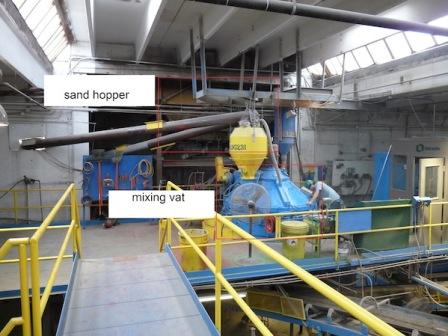Mastering Roof Inspections: Tile Roofs, Part 3
by Kenton Shepard and Nick Gromicko, CMI®
The purpose of the series “Mastering Roof Inspections” is to teach home inspectors, as well as insurance and roofing professionals, how to recognize proper and improper conditions while inspecting steep-slope, residential roofs. This series covers roof framing, roofing materials, the attic, and the conditions that affect the roofing materials and components, including wind and hail.
Concrete tiles are available in all three profiles, and as overlapping and interlocking tiles.
They’re manufactured from a variety of cementitious materials: Portland cement, modified Portland cement, or blended cement; ground and granulated blast-furnace slag; standard and lightweight aggregates; and a variety of other materials that are designed to increase the tiles’ strength and durability. Clay and concrete tiles are cast in molds.
Westile is a roofing products and concrete tile manufacturer. InterNACHI visited their plant in Golden, Colorado for a closer look at the manufacturing process.

1. Sand is a major component of the mixture from which tiles are made. Sand from a huge pile outside is lifted into a tower by a conveyer belt. From the tower, it’s moved by gravity into the sand hopper. When the hopper reaches a pre-set weight, sand stops flowing into it, doors in the bottom of the hopper open, and sand is carried to the mixing vat by a conveyor belt. Water and admixtures are added to the vat as the ingredients are blended by paddles.

2. Once the ingredients are mixed, the mud rides a conveyor belt to a vertical chute that fills trays. Mud in the trays is automatically screeded, troweled and cut as it rides another conveyor belt to the racks that will be mechanically loaded onto a cart that will take them into the kilns to be fired.

3. Once they have been fired, the trays ride the cart back to be mechanically unloaded onto another conveyor that eventually separates the tiles from their trays.

4. Fired tiles continue down the conveyor to be stacked on pallets and wrapped. The trays return on a separate conveyor to be oiled and re-filled. The process is a circuit that continues until the order for a certain number of tiles has been filled.
Manufacturing Problems
The porosity of concrete tile may affect its durability. One sign of overly porous tile is efflorescence. Efflorescence is the accumulation of calcium carbonate that appears on the surface of the tile as a white powder. Overly porous tile may absorb excessive amounts of moisture that can then freeze, weakening the tile. Another visible form of excessive porosity is spalling, where the surface of the tile has deteriorated, often due to the freezing of absorbed moisture.
Some manufacturers use an acrylic sealer to help prevent moisture absorption. The appearance of the tiles may change over the years as the sealer weathers away. As the sealer weathers, the tiles may appear to change color. This is not a defect or a performance problem.
Shrinkage Cracks
During manufacture, tiles may dry faster around the edges than in toward the center. This differential drying rate can result in cracking. Shrinkage cracks can create areas of weakness that result in breakage when the tile is stepped on.
Warranties
Although many tiles are warranted for 50 years, most manufacturers have not been around that long, so tile warranties are more of a sales tool than an accurate means for predicting the expected lifespan of the tile.
Underlayment
Since tile is not a waterproof roof-covering material but a water-resistant system, underlayment acts as a second line of defense against moisture intrusion. The IRC requires a minimum of 30-pound felt underlayment to be installed beneath both clay tiles and cementitious tiles, such as concrete.

Underlayment should be fastened with gasketed nails, such as plastic caps (shown above) to help seal nail holes.
Modern building codes call for underlayment beneath concrete tile to be a minimum of 30-pound felt or mineral-surfaced roll roofing.
Low-slope conditions -- that is, roofs with a slope of 2:12 to 4:12 -- should have a double layer of underlayment beneath all of the tiles.

This means that underlayment should be overlapped a minimum of 19 inches. Some manufacturers may require a waterproof membrane on low-slope roofs.
For slopes greater than 4:12, underlayment must overlap a minimum of 2 inches.
You can see the difference between the two in the photo above. The lower roof is low-slope with underlayment lapped 19 inches. The upper roof has underlayment installed with a 2-inch overlap.
Concrete Tile Installation
The installation method for concrete tiles varies, depending on the tile design. Tiles may rest directly on the underlayment, they may rest on battens installed parallel to the eaves, or they may rest on a grid of battens installed both parallel to and perpendicular to the eaves. The grid method is usually used to improve drainage beneath the tiles, with the battens resting on the underlayment installed perpendicular to the ridge to allow any runoff penetrating the tile roof-covering to flow easily.
Battens parallel to the ridge and eaves are installed to keep tiles aligned and to help hold them in place.
Joint Alignment

**************************************************
Learn how to master a roof inspection from beginning to end by reading the entire InterNACHI series: Mastering Roof Inspections.
Take InterNACHI’s free, online Roofing Inspection Course
Mastering Roof Inspections
Roofing Underlayment Types
Inspecting Underlayment on Roofs
Fall-Arrest Systems
Roofing (consumer-targeted)
More inspection articles like this

